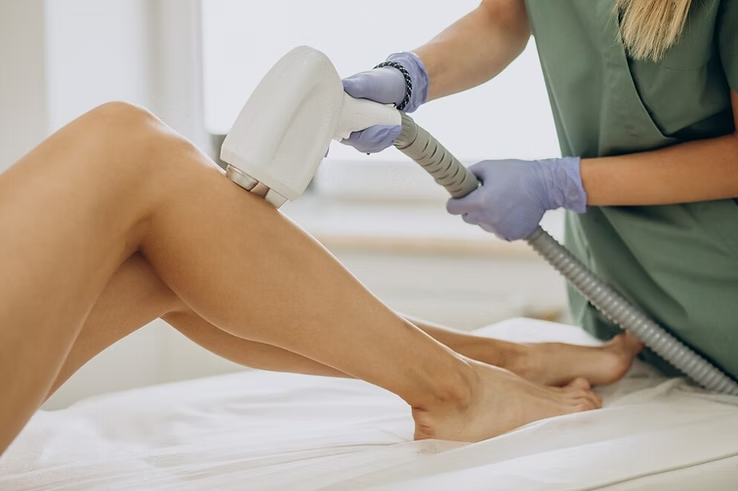If you’ve been thinking about laser hair removal in Whitby or are curious about lip injections in Whitby, you’re probably asking yourself: how many sessions for laser hair removal will I actually need? Understanding your treatment plans, managing your budget, and setting realistic expectations for your removal journey are crucial.
To achieve long-lasting, smooth skin, laser hair removal is one of the most popular ways. Since it targets hair at the root, it provides permanent results compared to waxing or shaving. It is important to remember that such results don’t happen overnight. Let’s dive deeper into what determines how many sessions you might need.
How Laser Hair Removal Works
Well, hair follicles are targeted and destroyed using concentrated light in laser hair removal. By damaging the follicle, hair growth is slowed down and eventually stopped. Multiple sessions are required to achieve full results, since not all hair grows at the same time.
Here’s a quick look at hair growth cycles:
- Anagen (growth phase): Hair is actively growing; most responsive to lasers.
- Catagen (transition phase): Hair is detaching from the follicle; less responsive.
- Telogen (resting phase): Hair is dormant; laser has minimal effect.
Because not all hairs are in the growth phase at the same time, several sessions are required.
How many sessions for laser hair removal will I need is explained.
Average Number of Laser Hair Removal Sessions
Well, how many laser hair removal sessions are needed? It may vary from person to person but on average, 6 to 10 sessions are required to achieve noticeable and lasting hair reduction.
Detailed breakdown by body area:
Underarms
- Hair is typically coarse.
- Sessions needed: 6-8
- Occasional touch-ups may be needed for maintenance.
Bikini Area
- Includes full, Brazilian, or partial styles.
- Hormones influence hair growth.
- Sessions needed: 6-10
Legs
- Larger areas usually have finer hair.
- Sessions needed: 3-6
- Thicker and darker hair tends to respond faster.
Face
- Hormonal areas, such as the upper lip and chin, require more attention.
- Sessions needed: 8-10
- Maintenance treatments are often necessary.
Arms
- Hair tends to be fine.
- Sessions needed: 5-8
Factors That Affect How Many Sessions Are Needed for Laser Hair Removal
How many treatments you’ll actually need can be affected by multiple factors. Realistic expectations can be set knowing these :
- Skin Tone: Darker skin may require more sessions due to melanin’s increased absorption of laser energy.
- Hair Color: Darker hair responds more effectively than lighter or grey hair.
- Hair Thickness: Coarse hair generally requires fewer sessions.
- Hormonal Influence: Areas affected by hormones, like the face or bikini line, may grow back faster.
- Area Size: Larger areas naturally require more sessions for complete coverage.
You can better understand how many laser hair removal sessions will suit your personal needs by considering these factors.
Tips For Best Results
For the enhancement of results and to possibly reduce the number of sessions, follow these simple steps:
- Avoid sun exposure for at least two weeks before and after your session.
- Instead of waxing or plucking, which can remove the follicle targeted by the laser, it is recommended to shave.
- Stick to your scheduled sessions to maintain consistency.
- To prevent irritation or dryness, keep skin moisturized.
- Changes in skin condition or new medications should be reported to your technician.
Each session can be as effective as possible with these small adjustments.
Selecting the Right Clinic
Choosing a qualified and experienced clinic is just as important as the treatment itself.
When picking a clinic, look for:
- Certified and experienced technicians
- Advanced laser equipment
- Positive customer reviews
- A detailed consultation to discuss your goals
You will be guided to the right number of treatments, and a trustworthy clinic will tailor a plan to your needs. Therefore, allowing you to get the best results and answers to the question of how many sessions of laser hair removal are needed, clearly and accurately.
The Process:
Expectations can be clarified, and nerves can be calmed by understanding the process:
- Duration: Depending on the area, sessions may vary; smaller areas, such as the upper lip, may take 10-15 minutes, while larger areas, such as the legs, may take up to an hour.
- Sensation: Many report a mild snapping sensation on the skin, but it’s generally tolerable.
- Recovery: Minimal downtime is needed, though some redness or slight swelling may appear.
- Results: After a few sessions, hair reduction becomes noticeable, with the best results being achieved after completing the full course.
You can feel more comfortable and confident about starting your treatments by knowing what to expect.
Conclusion
Laser hair removal is a long-term solution for many unwanted hairs, but patience and planning are required. Most people require 6 to 10 sessions. The total number of sessions can vary depending on factors such as skin type, hair color, and hormonal factors. To maximize your results, be sure to follow proper pre- and post-care instructions and choose a reputable clinic. With the right approach, you can enjoy smooth, hair-free skin for years to come.
FAQs
Q1: For facial hair, how many laser hair removal sessions are needed?
For stubborn areas with periodic maintenance, 8 to 10 sessions are typically required.
Q2: Can I do laser hair removal on light or grey hair?
Additional sessions may be required for light, red, or grey hair since lasers target pigment.
Q3: How frequently should I schedule the sessions?
Depending on the area being treated and hair growth cycles, sessions are usually spaced 4-6 weeks apart.
Q4: Is laser hair removal permanent?
Laser hair removal significantly reduces hair growth, but occasional touch-ups may be required due to hormonal changes.
Q5: Does the procedure hurt?
The pain is often compared to the snap of a rubber band against the skin, which might decrease as you get used to the discomfort.

